Sensory Research China
What is Sensory Research and why does Daxue Consulting apply it in China?
Sensory research is a scientific research methodology that uses the principles of experimental design and statistical analysis of the human senses. The five human senses are a valuable element to consider. The human brain receives information through them and compares it to earlier experiences. Finally, purchase decisions are a combination of ratio and emotion, whereby the latter has become more and more important in an era of information overload:

Olfactometric (sense of smell)
Humans have about a thousand different olfactory receptors. The association of particular scents with specific memories and experiences is an important aspect to consider when doing business. It is, for instance, possible to have a smell experience now and recall the scent later. For example, remembering the smell in a restaurant or a particular shop, which may lead customers to recognize a specific brand without seeing the logo.

Gustatory (sense of taste)
The concept of taste is often more related to the customer’s whole sensory experience, as the perceived taste usually comprises scent, sound, design, and texture, besides the actual taste. Therefore, it is crucial to match the product to consumers’ preferences concerning food and beverage.
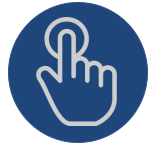
Haptic (sense of touch)
The tactile sense contributes to building a form sense, which helps remember and relive how something feels through only looking at it. Thus, brands can create an image around the product or service. That can be, for example, textiles or skincare products but also the material of any device may be perceived differently.

Optic (sense of vision)
Sight is a powerful human sense. It helps decide when buying a product, which means creating brand awareness and identity with distinguishing characteristics through visualization help customers recognize a brand and clarify the goods and services. That can be, for instance, a logo or color or light that distinguishes your brand from other players.
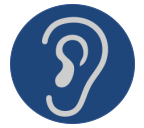
Acoustic (sense of hearing)
Customers react with feelings to music and voices. Businesses, therefore, can use this opportunity to create a signature sound that characterizes and strengthens its brand. That can be the ‘click’-sound when you close the door of cars or the music in the POS influencing customers’ buying behavior.
The result of reactions of one or more of the human senses to the so-called “stimuli” (elements triggering the reaction) is called sensory experience.
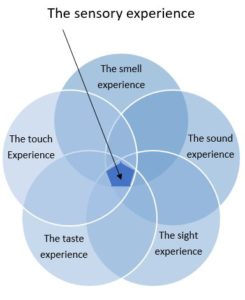
[Source: Daxue Consulting – Sensory research China]
CONTACT US NOW TO FURTHER DISCUSS HOW TO ANSWER YOUR NEED IN CHINA
As a China tech consulting, Daxue Consulting uses sensory research, sometimes also called sensory analysis or sensory evaluation, to evaluate consumers’ perceptions of a product’s taste, color, smell, texture, or sound (in most cases background music at POS). Products are therefore at the heart of sensory research projects, and Daxue Consulting utilizes the method for numerous applications with new, as well as existing products in various industries.
- Product launches
- Product adaptation and development
- Recipe change evaluation (ideal technological components or food ingredients)
- Shelf life determination
- Quality control
- Product profiling (identify a product’s sensory signature)
- Evaluation of goods under repeat consumption
- Sensory competitor benchmarking
- Marketing & Branding
- and more.
Business objectives may include having fewer production costs but still the same reaction from customers, boosting sales through higher quality, or benchmark a product and its performance to the key competitors. Product testing through sensory research is the key to reaching these goals. Is it further classified into?
- Monadic testing (where a single sample is assessed)
- Proto-monadic testing (where samples are presented as pairs, assessing the first one monadically and comparing the second one directly to it)
- Sequential monadic testing (where samples are assessed individually in a series)
- Comparative or simultaneous testing (where samples are presented and evaluated together, requiring comparative judgments such as the triangle test).
Product adaptation is particularly necessary for China. Companies that come to China with a product or concept directly imported from their home markets are rarely very successful. In China, taste preferences, perceptions, and acceptance of designs or colors are different. Language use and branding are also understood, perceived, and accepted in a variety of ways. Chinese culture is unlike that of any other country, and product localization (for most products) is crucial. Thus, sensory research in China is an effective and efficient tool which allows Daxue Consulting to aid companies in understanding the preferences of the Chinese consumer which facilitates and speeds up decision-making processes and develop highly liked products. Thus, increasing customer satisfaction, which in turn impacts their buying behavior.
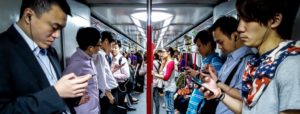
[China technology consulting services]
Sensory research comprises a broad range of test methods
Daxue Consulting utilizes a variety of different test methodologies and options of how to cross-analyze actual product properties and personal consumer liking, how consumers react to these properties. The different methods are used to answer the following fundamental questions:
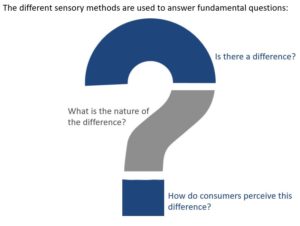
[Source: Daxue Consulting – Sensory research in China]
-
- Is there a difference?
-
- What is the nature of the difference?
- How do consumers perceive this difference?
The research team at Daxue Consulting selects and executes the tasks which are best suited for each research project. Sensory analysis is quite complex and branching. However, there are two broad categories of sensory testing:
- Objective, which provides actual data about the product and are carried out by highly trained panelists; the procedure is difficult and complicated and requires expertise in screening, recruiting, and training
- Subjective, which provide personal data on acceptability, liking, or preference, and are carried out by untrained assessors – such as local customers
Objective methods include descriptive tests and discrimination tests, which are sometimes also called difference tests. Subjective methods are known as effective tests, sometimes called consumer tests.
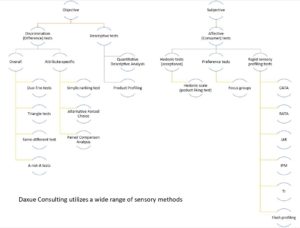
[Source: Daxue Consulting – China technology consulting services]
Daxue Consulting executes discrimination tests to evaluate if products or particular characteristics are different or hold similarities among samples. Our research team distinguishes two types of difference tests; Our China tech consulting team utilizes:
Overall difference tests, such as the Duo-Trio tests (where two test samples are compared to one reference sample), Triangle tests (comparison of three coded test samples, where two are the same and one is different), Same-different tests or A-not-A tests (to determine if a difference exists)
Attribute-specific methods, as for instance, the simple ranking test (to determine if a difference exists between three or more samples with regards to a particular attribute such as the intensity of fragrance), the Alternative Forced Choice (AFC) or the Paired Comparison Analysis (to determine if a difference exists between two samples with regards to a particular attribute)
Whereby the latter, also known as the pairwise comparison, is the most common one. It helps you investigate the relative importance of different options, for instance, to pick the most important problem or the most efficient solution.
Our team further employs descriptive tests to identify and quantify the various characteristics within the product profile. Therefore, descriptive tests provide the most comprehensive information about the ‘sensory fingerprints’ of a product. The most common methods our China tech consulting company applies are the Quantitative Descriptive Analysis (QDA) and Product Profiling. These are objective and quantitative methods, whereby high-trained panelists assess a variety of sensory characteristics (such as appearance, texture, taste, …) thr ough certain techniques, such as generating an agreed list of attributes and perceived intensity online scales.
ough certain techniques, such as generating an agreed list of attributes and perceived intensity online scales.
However, the language is, compared to effective tests, a descriptive one and non-hedonic. It means, the panelists are not asked how much they like the product, they are trained to give a standardized quantitative sensory response, and those are statistically analyzed using ANOVA (One-Way Analysis of Variance with R). The tests require a complicated screening. Daxue usually hires panelists aged between 20 and 30 because of the development of the taste bulbs and additionally checks behavior such as non-smoking or coffee drinkers, to receive reliable data. Tatiana Kuzmina, Daxue’s sensory research project leader, explains, “The assessors identify a targeted sample with, for instance, sweetness zero, and compare every other sample to this one. It is in science. It’s all about the attribute presence and what the product contains.”
Moreover, Daxue’s team runs effective tests to gain subjective data about product attributes (such as size, color, taste) and insight into the ‘drivers of liking’ of (potential) customers as they evaluate each attribute. Our research team distinguishes hedonic (acceptance) and preference testing. Key questions concerning acceptability include ‘Do you like this product? How much do you like it? What do you like about it?’; Compared to preference questions ‘Which product do you prefer? ’Depending on the objective of our client, these tests may be carried out as blind tests. Our consultant team runs the acceptance tests primarily with the hedonic scale (also known as the product liking test). The samples are presented to the testers who need to rate them on a 9-point scale ranging from “extremely dislike” to “extremely like,” as well as different attributes such as sweet, sour, the texture, or the overall liking. The preference tests, on the contrary, compare two samples to find which product was the participants’ favorite and are usually complemented by hedonic tests.
With additional qualitative data through focus groups or interviews, these China tech consulting methods help us to understand how well consumers will accept the products and their characteristics compared to those of key competitors, what the key attributes, the so-called ‘drivers of liking’ are, and which of them the Chinese consumers prefer most.
Additionally, our research team runs ‘rapid’ sensory profiling tests, such as ranking tests, CATA-tests (check-all-that-apply), RATA-tests (rate-all-that-apply), JAR-tests (just-about-right-scales), IPM (Ideal Profile Method, where assessors rate the overall liking of products and additionally its perception and ideal intensity from a list of attributes), flash profiling (where experienced panelists use own words to comparatively analyze a product set), TI-methods (time intensity techniques to measure change in sensory perception over time), and more.
Sensory data analysis is carried out using scientometrics, which is a specialized field of statistics called, a study of how to evaluate and analyze data. Statistician experts, such as Evelyn Chen, our specialist in that area evaluates data with different software and a lot of complicated formulas to calculate the level of errors and receive reliable results.
Additionally, Daxue analyzes relations between product data, their sensory attributes, and consumer liking through multidimensional statistical techniques such as the Principle Component Analysis (PCA), preference mapping through the Partial Least Squares (PLS) Regression, or the Conjoint analysis. These methods help our team to identify the relative impact of different characteristics, thus used to predict consumer behavior or evaluate the optimum combination of “drivers of liking.” The team visually displays results to simplify interpretation and to communicate findings, by, for instance, sensory (PCA) maps, or spider charts.
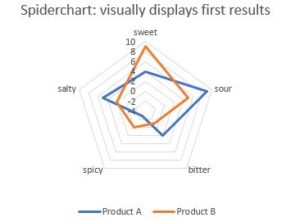
[Source : Daxue Consulting – sensory research in China]
Sensory testing: Market research approaches
Sensory testing is conducted under controlled conditions (sensory rooms, sensory testing laboratories), to not distract participants, as human judgments can easily be affected by the environment, as well as psychological or physiological factors. Daxue’s sensory professionals are aware of the factors and ensure to eliminate such bias by providing appropriately tailored facilities according to the project (such as for instance partitions, recording, light & sound control systems). However, some long-term descriptive studies require to be carried out at the assessors’ home, called Home Usability Testing (HUT), where videos and photos support the research process.

[Source: Daxue Consulting – China technology consulting services]
Central Location Testing (CLT)
Central location testing (CLT) is a qualitative market research approach, which takes place in a specific, controlled environment. CLT is the practical way of implementing the survey which ensures high-quality results and offers key advantage of Face to Face interview which is assessed as the most suitable method for testing concepts, products, packaging, advertising effectiveness as well as conducting sensory research.
Central location testing market research approach offers researchers several key advantages vs. other approaches, such as home-user tests:
- Since the environment is controlled, the researcher can eliminate bias. For example, all participants can be shown a series of products in the same order, packaging, etc;
- Researchers can obtain candid “raw” feedback based not just on what participants say, but also by what they do not say, and what their body language conveys;
- Researchers can dig deeper by asking participants follow-up questions based on their reactions and responses.
Combine Daxue Consulting’s expertise in the methodology and the Chinese market
Get sensory insights by interconnecting meaningful consumer feedback with detailed product understanding. Additionally, gain significant knowledge about the latest market trends, business potentials, and its challenges. Thus, establishing a powerful competitive advantage in the Chinese market!
No matter if you are already operating in the Chinese market or planning a market entry if you seek to develop a product, or to improve your brand without changing the product, Daxue Consulting will plan and carry out every aspect of sensory research, providing:
- Participants (trained assessors and local customers)
- Facilities
- Venue
- Experienced Moderator
- Data collection
- Data Mining & Analysis
- Full Report& Visualization
To know more about the methodology, our China technology consulting services or how Daxue Consulting performs them, please don’t hesitate to contact our consultants in China, visit our Blog or view our sensory case study.
Learn more about our other China technology consulting services:
- Mystery Shopping China
- Consumer Panel China
- Alternative data in China
- China tech advisory
- Eye tracking in China
- VR and AI in China

